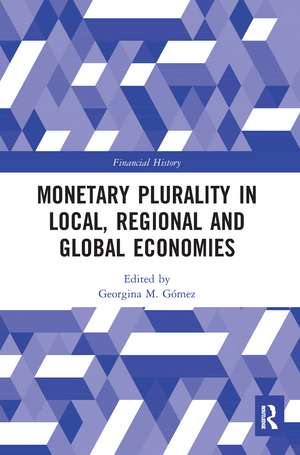Monetary Plurality in Local, Regional and Global Economies: Financial History
Editat de Georgina M. Gómezen Limba Engleză Paperback – 30 iun 2020
This book discusses ‘monetary plurality’, which is the circulation of several currencies at the same time and space. It addresses how multiple currency circuits work together and transform socio-economic systems, particularly by supporting economies at the local level of regions and cities. The book shows that monetary plurality has been ubiquitous throughout history and persists at present because the existence of several currency circuits facilitates small-scale production and trade in a way that no single currency can accomplish on its own.
Monetary plurality can improve resilience, access to livelihoods and economic sustainability. At the same time, it introduces new risks in terms of economic governance, so it needs to be properly understood. The book analyses experiences of monetary plurality in Europe, Japan, and North and South America, written by researchers from East and West and from the global North and South. Replete with case studies, this book will prove a valuable addition to any student or practitioner’s bookshelf.
Din seria Financial History
-
 Preț: 312.13 lei
Preț: 312.13 lei -
 Preț: 489.26 lei
Preț: 489.26 lei -
 Preț: 449.41 lei
Preț: 449.41 lei - 26%
 Preț: 846.09 lei
Preț: 846.09 lei -
 Preț: 449.41 lei
Preț: 449.41 lei -
 Preț: 489.26 lei
Preț: 489.26 lei -
 Preț: 445.89 lei
Preț: 445.89 lei -
 Preț: 449.41 lei
Preț: 449.41 lei -
 Preț: 489.26 lei
Preț: 489.26 lei - 25%
 Preț: 768.30 lei
Preț: 768.30 lei -
 Preț: 449.41 lei
Preț: 449.41 lei -
 Preț: 449.41 lei
Preț: 449.41 lei -
 Preț: 329.88 lei
Preț: 329.88 lei -
 Preț: 449.41 lei
Preț: 449.41 lei -
 Preț: 329.88 lei
Preț: 329.88 lei -
 Preț: 449.41 lei
Preț: 449.41 lei - 18%
 Preț: 1107.61 lei
Preț: 1107.61 lei -
 Preț: 449.41 lei
Preț: 449.41 lei -
 Preț: 449.41 lei
Preț: 449.41 lei -
 Preț: 449.41 lei
Preț: 449.41 lei -
 Preț: 449.41 lei
Preț: 449.41 lei -
 Preț: 449.41 lei
Preț: 449.41 lei -
 Preț: 323.23 lei
Preț: 323.23 lei -
 Preț: 449.41 lei
Preț: 449.41 lei - 18%
 Preț: 1107.16 lei
Preț: 1107.16 lei - 18%
 Preț: 1053.92 lei
Preț: 1053.92 lei -
 Preț: 449.41 lei
Preț: 449.41 lei -
 Preț: 449.41 lei
Preț: 449.41 lei - 26%
 Preț: 765.43 lei
Preț: 765.43 lei
Preț: 312.43 lei
Preț vechi: 356.63 lei
-12% Nou
Puncte Express: 469
Preț estimativ în valută:
59.78€ • 62.55$ • 49.66£
59.78€ • 62.55$ • 49.66£
Carte tipărită la comandă
Livrare economică 03-17 aprilie
Preluare comenzi: 021 569.72.76
Specificații
ISBN-13: 9780367587598
ISBN-10: 0367587599
Pagini: 314
Dimensiuni: 156 x 234 mm
Greutate: 0.45 kg
Ediția:1
Editura: Taylor & Francis
Colecția Routledge
Seria Financial History
Locul publicării:Oxford, United Kingdom
ISBN-10: 0367587599
Pagini: 314
Dimensiuni: 156 x 234 mm
Greutate: 0.45 kg
Ediția:1
Editura: Taylor & Francis
Colecția Routledge
Seria Financial History
Locul publicării:Oxford, United Kingdom
Public țintă
Postgraduate and UndergraduateCuprins
List of Figures; List of Tables; List of Contributors; Acknowledgements; 1. The monetary system as an evolutionary construct Georgina M. Gómez; 2. Monetary Plurality in Economic Theory Jérôme Blanc, Ludovic Desmedt, Laurent Le Maux, Jaime Marques-Pereira, Pepita Ould-Ahmed and Bruno Théret ; 3. Making sense of the plurality of money: a Polanyian attempt Jérôme Blanc; 4. How does monetary plurality work at the household level? The division of labour among currencies in Argentina (1998-2005) Georgina M. Gómez; 5. Monetary federalism as A concept and its Empirical underpinnings in Argentina’s monetary history Bruno Théret; 6. Famine of Cash: Why Have Local Monies Remained Popular throughout Human History? Akinobu Kuroda; 7. The pervasiveness of monetary plurality in economic crisis and wars Georgina M. Gómez and Wilko von Prittwitz und Gaffron; 8. Birth, Life and Death of a Provincial Complementary Currency from Tucuman, Argentina (1985 – 2003) Bruno Théret; 9. Community Currency and Sustainable Development in Hilly and Mountainous Areas: A Case Study of Forest Volunteer Activities in Japan Yoshihisa Miyazaki and Ken-ichi Kurita; 10. Sustainable Territorial Development and Monetary Subsidiarity Marie Fare; 11. Relationship between people's money consciousness and circulation of community currency Shigeto Kobayashi, Takashi Hashimoto, Ken-ichi Kurita and Makoto Nishibe; 12. Gaming Simulation using Electronic Community Currencies: Behavioural Analysis of Self-versus-Community Consciousness Masahiro Mikami and Makoto Nishibe; 13. For the policy maker: when and how is monetary plurality an option Georgina M. Gómez; Index
Notă biografică
Georgina M. Gómez is Associate Professor in Institutions and Local Development at the International Institute of Social Studies of Erasmus University Rotterdam, the Netherlands.
Descriere
Reforms to increase the responsiveness and flexibility of the monetary system can be part of the solution during financial and economic crisis. This book analyses experiences of monetary plurality in Europe, Japan, and North and South America. Replete with case studies, it is a valuable addition to any student or practitioner’s bookshelf.
